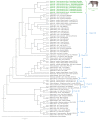Theileria terrestris nov. sp.: A Novel Theileria in Lowland Tapirs (Tapirus terrestris) from Two Different Biomes in Brazil
- PMID: 36557572
- PMCID: PMC9784709
- DOI: 10.3390/microorganisms10122319
Theileria terrestris nov. sp.: A Novel Theileria in Lowland Tapirs (Tapirus terrestris) from Two Different Biomes in Brazil
Abstract
The low-land tapir (Tapirus terrestris) is the largest wild terrestrial mammal found in Brazil. Although T. terrestris has been already reported as a host of hemoparasites, the occurrence and genetic identity of Piroplasmida agents in this species is still cloudy. Although it is reported that Theileria equi, an endemic equid-infective agent in Brazil, is occurring in lowland tapirs, these reports are probably misconceived diagnoses since they are solely based on small fragments of 18S rRNA that may not achieve accurate topologies on phylogenetic analyses. The present study aimed to detect and investigate the identity of Theileria spp. in tapirs from Pantanal and Cerrado biomes. Blood-DNA samples from tapirs were screened for a partial (~800 bp) 18S rRNA gene fragment from Piroplasmida and 64 (64/122; 52.46% CI: 43.66-61.11%) presented bands of expected size. Samples were submitted to different protocols for molecular characterization, including near-full length 18S rRNA gene (~1500 bp), and the ema-1 gene from T. equi. Eight sequences were obtained for extended fragments (1182-1473 bp) from the 18S rRNA gene. Moreover, three sequences from partial cox-1 and five from partial hsp70 gene were obtained. None of the samples presented amplifications for the ema-1 gene. Phylogenetic and distance analyses from the 18S rRNA sequences obtained demonstrated a clear separation from tapirs' Theileria spp. and T. equi. Phylogenetic analyses of cox-1 and hsp70 sequences obtained herein also showed a unique clade formed by tapir's Theileria spp. Theileria terrestris sp. nov. is positioned apart from all other Theileria species in 18S rRNA, cox-1, and hps70 phylogenetic analyses. This novel proposed species represents a new Piroplasmida clade, yet to be characterized regarding biological features, vectors involved in the transmission cycles, additional vertebrate hosts, and pathogenicity.
Keywords: Cerrado; Pantanal; Piroplasmida; tapirs; theileriosis; wildlife.
Conflict of interest statement
The authors declare no conflict of interest.
Figures






Similar articles
-
Survey of Piroplasmids in Wild Mammals, Unconventional Pets, and Ticks from Goiás State, Midwestern Brazil.Pathogens. 2025 Jun 12;14(6):585. doi: 10.3390/pathogens14060585. Pathogens. 2025. PMID: 40559593 Free PMC article.
-
Molecular survey of vector-borne agents in lowland tapirs (Tapirus terrestris) from Brazil reveals a new Anaplasma genotype.Acta Trop. 2024 Dec;260:107476. doi: 10.1016/j.actatropica.2024.107476. Epub 2024 Nov 27. Acta Trop. 2024. PMID: 39608660
-
Expanding the Universe of Hemoplasmas: Multi-Locus Sequencing Reveals Putative Novel Hemoplasmas in Lowland Tapirs (Tapirus terrestris), the Largest Land Mammals in Brazil.Microorganisms. 2022 Mar 14;10(3):614. doi: 10.3390/microorganisms10030614. Microorganisms. 2022. PMID: 35336189 Free PMC article.
-
The Piroplasmida Babesia, Cytauxzoon, and Theileria in farm and companion animals: species compilation, molecular phylogeny, and evolutionary insights.Parasitol Res. 2022 May;121(5):1207-1245. doi: 10.1007/s00436-022-07424-8. Epub 2022 Jan 31. Parasitol Res. 2022. PMID: 35098377 Review.
-
Equid infective Theileria cluster in distinct 18S rRNA gene clades comprising multiple taxa with unusually broad mammalian host ranges.Parasit Vectors. 2020 May 19;13(1):261. doi: 10.1186/s13071-020-04131-0. Parasit Vectors. 2020. PMID: 32430015 Free PMC article. Review.
Cited by
-
Using Digital PCR to Unravel the Occurrence of Piroplasmids, Bartonella spp., and Borrelia spp. in Wild Animals from Brazil.Pathogens. 2025 Jun 6;14(6):567. doi: 10.3390/pathogens14060567. Pathogens. 2025. PMID: 40559575 Free PMC article.
-
Molecular detection of piroplasmids in mammals from the Superorder Xenarthra in Brazil.Parasitol Res. 2023 Dec;122(12):3169-3180. doi: 10.1007/s00436-023-08008-w. Epub 2023 Oct 18. Parasitol Res. 2023. PMID: 37848747
-
Survey of Piroplasmids in Wild Mammals, Unconventional Pets, and Ticks from Goiás State, Midwestern Brazil.Pathogens. 2025 Jun 12;14(6):585. doi: 10.3390/pathogens14060585. Pathogens. 2025. PMID: 40559593 Free PMC article.
-
Tick-borne Apicomplexa in wildlife and ticks of French Guiana.Parasite. 2024;31:49. doi: 10.1051/parasite/2024052. Epub 2024 Aug 15. Parasite. 2024. PMID: 39162420 Free PMC article.
-
Phylogenetic Inferences Based on Distinct Molecular Markers Confirm a Novel Babesia Species (Babesia goianiaensis nov. sp.) in Capybaras (Hydrochoerus hydrochaeris) and Associated Ticks.Microorganisms. 2023 Aug 6;11(8):2022. doi: 10.3390/microorganisms11082022. Microorganisms. 2023. PMID: 37630582 Free PMC article.
References
-
- Schnittger L., Ganzinelli S., Bhoora R., Omondi D., Nijhof A.M., Florin-Christensen M. The Piroplasm Babesia, Cytauxzoon, and Theileria in farm and companion animals: Species compilation, molecular phylogeny, and evolutionary inshights. Parasitol. Res. 2022;121:1207–1245. doi: 10.1007/s00436-022-07424-8. - DOI - PubMed
-
- Acosta I.C.L., Costa A.P., Nunes P.H., Gondim M.F.N., Gatti A., Rossi J.L., Jr., Gennari S.M., Marcili A. Morphological and molecular characterization and phylogenetic relationship of a new species of trypanosome in Tapirus terrestris (lowland tapir), Trypanosoma terrestris sp. nov., from Atlantic Rainforest of southeastern Brazil. Parasit. Vectors. 2013;6:349. doi: 10.1186/1756-3305-6-349. - DOI - PMC - PubMed
-
- Mongruel A.C.B., Medici E.P., Canena A.D.C., Calchi A.C., Machado R.Z., André M.R. Expanding the Universe of Hemoplasmas: Multi-Locus Sequencing Reveals Putative Novel Hemoplasmas in Lowland Tapirs (Tapirus terrestris), the Largest Land Mammals in Brazil. Microorganisms. 2022;10:614. doi: 10.3390/microorganisms10030614. - DOI - PMC - PubMed
-
- Gonçalves T.S., Barros F.N.L., Inoue L.S., Farias D.M., Lima J.S., Nobre A.V., Aidar E.S.A., Diniz R.F.R., Gering A.P., Scofield A. Natural Theileria equi infection in captive Tapirus terrestris (Perissodactyla: Tapiridae) in the Brazilian Amazon. Ticks Tick-Borne Dis. 2020;11:101452. doi: 10.1016/j.ttbdis.2020.101452. - DOI - PubMed
Grants and funding
LinkOut - more resources
Full Text Sources
Research Materials
Miscellaneous

